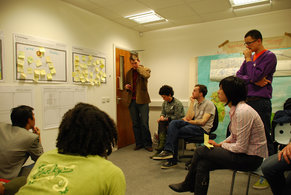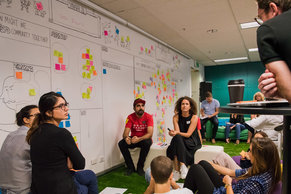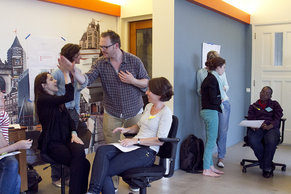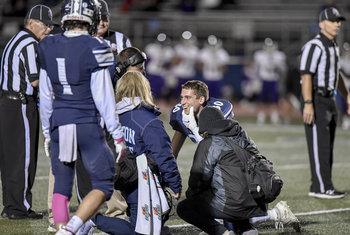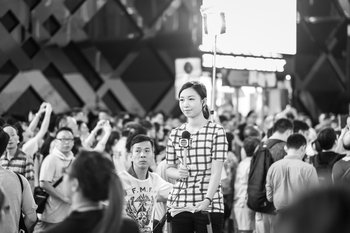
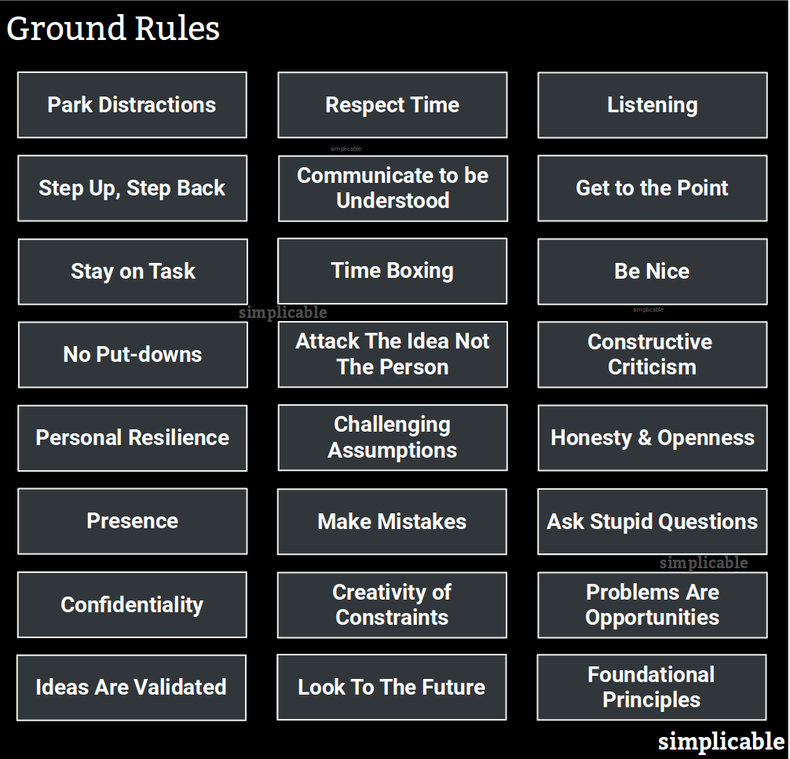
Park Distractions
The most common type of ground rule for meetings is a request for participants to avoid behaviors that may distract them and others such as the use of phones and consumption of food.Respect Time
Rules related to respecting people's time such as showing up, being on time and ending on time.Listening
A rule that one person talks at a time while the others listen with intent to understand.Step Up, Step Back
Guidelines that ask everyone to participate equally such that everyone talks and no one person dominates the conversation with long-winded speeches.Communicate to be Understood
Rules related to clear communication such as speaking at a reasonable volume and avoiding language such as jargon that makes your message less consumable.Get to the Point
Asking that people be clear, concise and direct.Stay on Task
A guideline that a group stay focused on a task list such as a meeting agenda as opposed to going off on a tangent.Time Boxing
A rule that you follow a schedule for a meeting such as 10 minutes per item.Be Nice
Rules related to affording people respect and allowing them to save face.No Put-downs
Specifically asking that people not insult each other. This type of rule may be viewed as condescending in a creative environment of adults where some level of wit and resilience can be expected.Attack The Idea Not The Person
Criticizing ideas as opposed to people.Constructive Criticism
A guideline that participants try to build upon each others ideas as opposed to attacking ideas in a non-constructive way. For example, the rules of improvisation can be useful for some types of creative exercises.Personal Resilience
Ground rules that suggest participants be tough. For example, a rule that no ideas are protected from criticism. This is appropriate for creative environments that are actually trying to get something done as opposed to echoing the status quo.Challenging Assumptions
Specifically asking participants to challenge prevailing assumptions and principles.Honesty & Openness
Asking for candor and information sharing as opposed to holding back information for some political gain.Presence
Asking that participants fully focus on an activity as opposed to day dreaming or resting.Make Mistakes
Encouraging participants to take risks by contributing brave ideas that may not work out.Ask Stupid Questions
The rule that there is no such thing as a stupid question is used to encourage people to openly acknowledge when they don't understand something. Pretending to understand is a common social behavior that results from a fear of looking unintelligent. This can cause a variety of problems, in the worst case an entire group may not understand an important piece of information with everyone pretending to understand.Confidentiality
A rule that information shared not leave the room or if it does leave the room that no names be associated with the information.Creativity of Constraints
Ground rules may encourage participants to tear down assumptions to allow far-fetched ideas to surface. Alternatively, ground rules may impose constraints designed to spark creativity. For example, a rule that all proposed solutions to a problem be implementable in a week.Problems Are Opportunities
A request for an optimistic and constructive approach to problem solving.Ideas Are Validated
A request for defensive pessimism.Look To The Future
A guideline that a conversation avoid dwelling on the past or present to look at how the future can be different.Foundational Principles
Ground rules may include principles that will be used to guide negotiation or idea generation. For example, ground rules for divorce mediation that state that a child's needs will be put first in all decisions.Notes
Ground rules can easily feel condescending, dull, restrictive or unintelligent. As such, the design of ground rules should consider the maturity of participants, culture of an organization and goals of an activity. For example, a group of investment banking executives probably don't need to be told to be nice to each other as they can be expected to have high personal resilience.Etymology
The term ground rules originates with baseball as each baseball park is typically allowed to adopt its own rules to handle the unique design of the ballpark. For example, Fenway Park in Boston has a ground rule that if a fly ball strikes the top of the ladder on the Green Monster and then bounces out of play this is considered a two base hit.| Overview: Ground Rules | ||
Type | ||
Definition | Special rules or guidelines that apply to a particular meeting, task, activity, conversation, negotiation, classroom, event or workshop. | |
Related Concepts | ||

